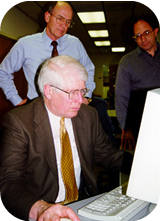|
HSRC
visitors share expertise, learn about Center projects
story
contents:
introduction | information exchange

"Rep.
David Price takes a virtual tour of the Pedestrian & Bicycle
Information Center developed by HSRC." |
Introduction
Several distinguished guests visited the Highway Safety Research Center
this winter and spring. In February, Congressman David Price toured
the HSRC and learned about on-going pedestrian and bicycle studies from
Center researchers. In 1999, HSRC won a five-year grant from the Federal
Highway Administration to create a Pedestrian and Bicycle Information
Center. During his visit, Price took a virtual tour of the information
center's new web site found at www.walkinginfo.org and www.bicyclinginfo.org
. Launched last fall, the site is being tailored to answer walking and
bicycling questions from everybody from engineers and sidewalk advocates
to health professionals, kids, parents, and congressional representatives.
top of page
Information exchange
Frank Francois, former executive director of the American Association
of State Highway and Transportation Officials (AASHTO) was another recent
HSRC visitor. Francois spoke to Center researchers of his recent involvement
in the field of "intelligent transportation systems," known as "ITS".
In a world with increasing numbers of drivers and limited places to
build or widen roads, many transportation experts believe that working
out a system for managing traffic flow is imperative. "I think the ITS
arena holds great promise for helping congestion," Francois said, although
he also cautioned: "No one anticipates that on the 4th Monday of October,
all problems will be solved. It involves changing attitudes. It involves
changing paradigms."
During his visit, Francois learned of HSRC's work in changing a different
paradigm — collegiate attitudes about drinking. Last fall, HSRC launched
a norms campaign at the University of North Carolina at Chapel Hill
aimed at changing the skewed student perception about how much students
drink. Primarily aimed at freshmen, the campaign used posters, stickers,
a web site and financial rewards handed out by the "prize patrol" to
spread the word that 66 percent of students returning home on any given
Thursday, Friday or Saturday night have a blood alcohol concentration
of .00 percent. The slogan for the campaign is "2 out of 3 .00 BAC."
These data are based on breath samples gathered from students by HSRC
researchers in the fall of 1997 as students returned home for the evening
to fraternities, sororities, residence halls and off-campus apartment
complexes. Data were collected all nights of the week between 10 p.m.
and 3 a.m. Last fall, a second round of data were collected from students.
These are being analyzed by HSRC researchers to determine the effectiveness
of the norms campaign.
top of page
|

